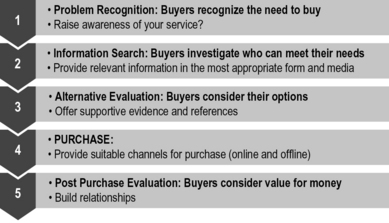7 After reading this chapter, students will be able to: • Appreciate the importance of market segmentation analysis. • Understand the value and measurement of setting suitable marketing objectives. • Appreciate the roles of branding and digital marketing. • Apply and adapt principal marketing concepts and frameworks for the benefit of a veterinary practice as part of an integrated marketing plan. In its truest form marketing could be seen as the strategy and process of putting the customer at the heart of the organization and developing the business around their needs. The Chartered Institute of Marketing (www.cim.co.uk) defines marketing as S = Situation analysis (or ‘Where are we?’) O = Objectives (or ‘What do we want to achieve?’) S = Strategy (or ‘How are we going to get there?’) T = Tactics (or ‘What tools are we going to use?’) A = Actions (or ‘When is it all taking place?’) C = Controls (or ‘How are we going to manage it and find out how well we have done?’) A simplified example is shown in Table 7.1. Table 7.1 An illustration of the use of the SOSTAC® model Source: Smith PR (2011) SOSTAC® Guide to writing the perfect plan, www.prsmith.org. Using quantitative data is important when establishing your target audience. It is too easy to be convinced that you have a large enough market even though this is often based on hearsay and anecdotes. Depending on your resources you could conduct your own market research using one of the free online services such as SurveyMonkey (www.surveymonkey.com), or simply ask your customers to complete a questionnaire while in the waiting room. Established research organizations such as Mintel and Keynote regularly produce reports on the UK pet market but they may be chargeable. The Chartered Institute of Marketing has a library service, and reports can be accessed and small portions copied under licence (see Chartered Institute of Marketing, 2012a). Alternatively, there are lots of websites providing information on the veterinary market. So, whether you are targeting businesses such as racing stables or families with small animals it really does not matter. The important thing is to appreciate their characteristics and what they are looking for. To help with this, you might refer to four over-arching criteria: geographic, psychographic, behavioural and demographic. Table 7.2 highlights some of the elements of each of these criteria. Table 7.2 Over the years there has been a lot of research exploring the process that individuals go through when in the ‘buying process’. While the scale varies considerably depending on whether it is a ‘big-ticket’ item such as agreeing terms on a new practice, or smaller everyday products such as worm, flea and parasite treatments, as consumers we all follow a process. For marketers, understanding this process, and adapting marketing and communications activity accordingly, can increase the number of new customers as well as improving customer retention and loyalty. Figure 7.1 illustrates this process and identifies some key marketing tactics that need to be considered. In his book, Competitive Strategy: Techniques for Analysing Industries and Competitors, Harvard University’s Michael Porter (2004) suggests that an organization has three options with regard to marketing strategy: cost leadership, product differentiation and focus (on specific target audiences). Unfortunately many organizations, and small businesses/practices in particular, lack clear direction and tend to fall into ‘no man’s land’, resulting in a weak and sometimes confusing ‘competitive advantage’. While there is a certain amount of flexibility in these options, having a clear and long-term view of the adopted strategy will help define the actual marketing activities you eventually select.
Applying marketing theory to veterinary practice
LEARNING OUTCOMES
Introduction
Marketing and sales
What is your plan?
Criteria
Description
S = Situation analysis
You have noticed that customer numbers are dropping year on year. Fewer people in your town have small pets and your costs have increased but you do not want to simply pass them on to the customers because a new competitor has opened up nearby.
Your customers think you do a good job but are becoming more cost conscious and are prone to ‘shop around’. By understanding the broader factors that impact on your practice your planning will be more effective.
O = Objectives
Internally you agree to target current customers with a view to ‘In 12 months, increasing the number of customers who come more than once by 50%’.
S = Strategy
Using the 7Ps model, you develop a plan to build relationships and offer new services that differentiate you from the competition and appeal to your potential and current customers.
T = Tactics
You need to create awareness and interest in your new Pet Plan, so you consider advertising but also need to make it easy for customers to buy. This might include advertising, running a sales offer, sponsoring the dog show at the annual fair, or providing leaflets in the waiting room. It might need training for front-line staff as well as information posted on your website. When it comes to promoting your products and services, remember to follow Lewis’s AIDA model: Awareness, Interest, Desire, Action!
A = Actions
After considering all these marketing tools you develop a schedule of activity for the next 12 months. Each element is costed and its effectiveness measured.
C = Controls
To ensure that you meet your set objectives you implement specific management and measurement techniques. This might include adapting a person’s job description, using Google Analytics or integrating your sales ledger with a marketing database.
Who is your audience?
Market segment criteria
Variables
Geographic
Rural, urban, local, national, international, etc.
Behavioural
Occasional/heavy use, loyalty status, attitudes, benefit sought
Psychographics
Social class, lifestyle, personality
Demographics
Age, income, education, family life stage
Consumer buying behaviour
Positioning your products and services
Veterian Key
Fastest Veterinary Medicine Insight Engine




